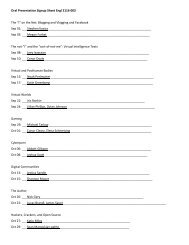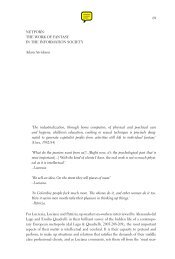- Page 2:
Digitizing Race
- Page 6:
Digitizing Race Visual Cultures of
- Page 10:
Contents Acknowledgments vii Introd
- Page 14:
Acknowledgments I have many people
- Page 18:
Acknowledgments ix My biggest intel
- Page 22:
Introduction Digital Racial Formati
- Page 26:
Introduction 3 project [that] avoid
- Page 30:
Introduction 5 ship as well as in n
- Page 34:
Introduction 7 at the prospect of c
- Page 38:
Introduction 9 industrial, technolo
- Page 42:
Introduction 11 the matrix of power
- Page 46:
Introduction 13 because socially co
- Page 50:
Introduction 15 out, illusory, espe
- Page 54:
Introduction 17 cultural capital an
- Page 58:
Introduction 19 digital bodies in b
- Page 62:
Introduction 21 Manovich’s semina
- Page 66:
Introduction 23 Figure I.3. Male sp
- Page 70:
Introduction 25 media, like films,
- Page 74:
Introduction 27 interactivity, just
- Page 78:
Introduction 29 television and film
- Page 82:
Introduction 31 as it develops in i
- Page 86:
Introduction 33 signatures are far
- Page 90:
Introduction 35 media practices tha
- Page 94:
1 “Ramadan Is Almoast Here!” Th
- Page 98:
“Ramadan Is Almoast Here!” 39 o
- Page 102:
“Ramadan Is Almoast Here!” 41 i
- Page 106:
“Ramadan Is Almoast Here!” 43 a
- Page 110:
“Ramadan Is Almoast Here!” 45 I
- Page 114:
“Ramadan Is Almoast Here!” 47 o
- Page 118:
“Ramadan Is Almoast Here!” 49 r
- Page 122:
“Ramadan Is Almoast Here!” 51 a
- Page 126:
“Ramadan Is Almoast Here!” 53 p
- Page 130:
“Ramadan Is Almoast Here!” 55 a
- Page 134:
“Ramadan Is Almoast Here!” 57 g
- Page 138:
Slide 4 Slide 5 Slide 6 Slide 1 Sli
- Page 142:
Figure 1.3. Animated GIF AIM buddy
- Page 146:
“Ramadan Is Almoast Here!” 63 A
- Page 150:
“Ramadan Is Almoast Here!” 65 b
- Page 154:
“Ramadan Is Almoast Here!” 67 f
- Page 158: “Ramadan Is Almoast Here!” 69 p
- Page 162: Alllooksame? 71 been the victims of
- Page 166: Alllooksame? 73 (such as the Univer
- Page 170: Alllooksame? 75 nese, Filipinos, Vi
- Page 174: Alllooksame? 77 in doorways, their
- Page 178: Alllooksame? 79 Figure 2.1. Alllook
- Page 182: Alllooksame? 81 Figure 2.2. A test
- Page 186: Alllooksame? 83 racial oppression,
- Page 190: Alllooksame? 85 the alllooksame.com
- Page 194: Alllooksame? 87 suck at HTML :( If
- Page 198: Alllooksame? 89 popular culture has
- Page 202: Alllooksame? 91 cal conviction that
- Page 206: Alllooksame? 93 both start from the
- Page 212: 96 The Social Optics of Race forms
- Page 216: 98 The Social Optics of Race second
- Page 220: 100 The Social Optics of Race Figur
- Page 224: 102 The Social Optics of Race Figur
- Page 228: 104 The Social Optics of Race are a
- Page 232: 106 The Social Optics of Race photo
- Page 236: 108 The Social Optics of Race Figur
- Page 240: 110 The Social Optics of Race Figur
- Page 244: 112 The Social Optics of Race norma
- Page 248: 114 The Social Optics of Race Figur
- Page 252: 116 The Social Optics of Race like
- Page 256: 118 The Social Optics of Race retai
- Page 260:
120 The Social Optics of Race are a
- Page 264:
122 The Social Optics of Race but t
- Page 268:
124 The Social Optics of Race the o
- Page 272:
126 The Social Optics of Race metap
- Page 276:
128 The Social Optics of Race partn
- Page 280:
130 The Social Optics of Race over
- Page 284:
132 Avatars and the Visual Culture
- Page 288:
134 Avatars and the Visual Culture
- Page 292:
136 Avatars and the Visual Culture
- Page 296:
138 Avatars and the Visual Culture
- Page 300:
140 Avatars and the Visual Culture
- Page 304:
142 Avatars and the Visual Culture
- Page 308:
144 Avatars and the Visual Culture
- Page 312:
146 Avatars and the Visual Culture
- Page 316:
Figure 4.3. Holly’s signature on
- Page 320:
150 Avatars and the Visual Culture
- Page 324:
152 Avatars and the Visual Culture
- Page 328:
154 Avatars and the Visual Culture
- Page 332:
156 Avatars and the Visual Culture
- Page 336:
158 Avatars and the Visual Culture
- Page 340:
160 Avatars and the Visual Culture
- Page 344:
162 Avatars and the Visual Culture
- Page 348:
164 Avatars and the Visual Culture
- Page 352:
166 Avatars and the Visual Culture
- Page 356:
168 Avatars and the Visual Culture
- Page 360:
170 Avatars and the Visual Culture
- Page 364:
172 Measuring Race on the Internet
- Page 368:
174 Measuring Race on the Internet
- Page 372:
176 Measuring Race on the Internet
- Page 376:
178 Measuring Race on the Internet
- Page 380:
180 Measuring Race on the Internet
- Page 384:
182 Measuring Race on the Internet
- Page 388:
184 Measuring Race on the Internet
- Page 392:
186 Measuring Race on the Internet
- Page 396:
188 Measuring Race on the Internet
- Page 400:
190 Measuring Race on the Internet
- Page 404:
192 Measuring Race on the Internet
- Page 408:
194 Measuring Race on the Internet
- Page 412:
196 Measuring Race on the Internet
- Page 416:
Figure 5.3. Wired magazine cover fr
- Page 420:
200 Measuring Race on the Internet
- Page 424:
Epilogue The Racio-Visual Logic of
- Page 428:
204 Epilogue cases. And online peti
- Page 432:
206 Epilogue from this strict indus
- Page 436:
208 Epilogue race as its best and m
- Page 440:
This page intentionally left blank
- Page 444:
212 Notes to Introduction 14. This
- Page 448:
214 Notes to Chapter 2 17. A QuickT
- Page 452:
216 Notes to Chapter 2 18. Original
- Page 456:
218 Notes to Chapter 3 3. Haraway,
- Page 460:
220 Notes to Chapter 4 51. Gunning,
- Page 464:
222 Notes to Chapter 4 17. Rob Walk
- Page 468:
224 Notes to Chapter 5 13. Alkalima
- Page 472:
226 Notes to Epilogue Epilogue 1. P
- Page 476:
228 Bibliography Barlow, John Perry
- Page 480:
230 Bibliography Farred, Grant. Wha
- Page 484:
232 Bibliography Hofstadter, Dougla
- Page 488:
234 Bibliography Oliver, Kelly. Wit
- Page 492:
236 Bibliography Stabile, Carol A.
- Page 496:
This page intentionally left blank
- Page 500:
Electronic Mediations Katherine Hay
- Page 504:
242 Index Asian Americans: alllooks
- Page 508:
244 Index GIFs, 31-32, 44, 53, 65-6
- Page 512:
246 Index Novak, Thomas P., 179 NTI
- Page 516:
248 Index Webcam images: history of





